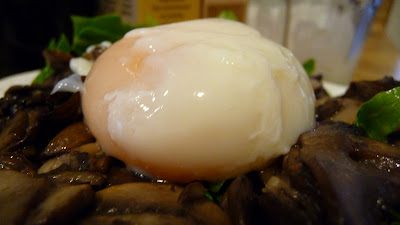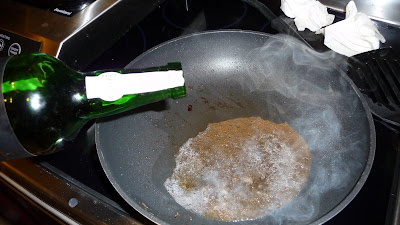So I got a phone call from my mom, asking me what I wanted from Mitsuwa Market. I was in the mood for some steak, so I told her to buy some good beef. And she certainly did. She bought two steaks, one which was a new york strip steak Angus Prime. The other was a Snake Valley Wagyu chuck steak. Both were about 0.68 lb, which was a bit small, but steak is steak.
*Note, please excuse my terrible photography in this post, as I am still learning how to take good photos of food.
The first steak was a Certified Angus Beef New York Steak.
Searing at a high heat is extremely important when cooking steak. By cooking at a high heat, the meat seals in all of its juices, and forms almost like an outer crust, which is crucial for a great steak.
Unfortunately I didn't put enough color on the steak, and was not able to get that crust on steaks that seal in the flavor of the meat. I should have seared the meat longer, but oh well...
After flipping the steak, lower the heat and add some butter with cracked garlic to bast the steak. Basting the steak with some butter and garlic is important, as it adds flavor and depth to the meat, elevating the steak to a whole new dimension.
After cooking the steak and taking it off the pan, I made a sauce consisting of beef stock and port wine with the beef scrapings on the pan. I reduced it until it thickened.
The reduced sauce...
After resting for about 8 minutes, I cut into the steak, hoping for a good medium rare to rare. I was pleased with the color, as the beef turned out to be just about medium rare.
Duo of Beef: One way with port wine reduction with a Crème fraiche horseradish sauce; the other with some Yuzu Kosho, a Japanese condiment made from yuzu, yuzu rind, japanese pepper (sansho), and pepper. Yuzu Kosho could be bought at your local Asian food market.
The Result: The classic American steak taste; the meat had a great texture which was complimented with the Port Wine sauce as well as the horseradish sauce. The Yuzu Kosho, on the other hand, had a kick to it, and truly heightened the flavor of the beef. The beef, however, could have tasted better with a better outer crust to it.
The next beef was a Snake River Valley Chuck Steak. Snake River Valley Farms are known to raise cattle in the US similar to cows that produce Kobe Wagyu Beef in Japan. The beef from Snake River Farms (aka American Wagyu) is known to have similar marbling and texture, but I'll judge that after eating. Note the marbling of fat on this compared to the lean Angus New York Steak.
 Like the Angus beef, the American Wagyu was cooked at a high heat to form the steak crust.
Like the Angus beef, the American Wagyu was cooked at a high heat to form the steak crust.
What a crust! I was very pleased with the crust on this steak. Compare the crust on this compared to the crust on the Angus beef, as you can tell that the browning on this steak is much darker and more evenly distributed throughout the steak.
Basting the steak with butter and garlic.
There was much more scrapings on the pan on the American Wagyu compared to the Angus beef, so I added more stock and wine to make the wine reduction. The portion of wine and stock was proportional to that of the reduction with the Angus beef.
The beef had great color, as I was looking to make this steak a bit more rare than Angus beef.
Eaten with the wine reduction and the Crème fraiche horseradish mix.
The Result: An extremely rich and buttery flavor, almost similar to that of foie gras. Unlike the Angus beef, the American Wagyu had marbling which significantly made the beef much more tender and flavorful than the Angus beef. The horseradish and meat came together perfectly, as the horseradish had a kick which complimented the richness of the American Wagyu.
Of course my parents wanted in on some of the beef, but they wanted the American Wagyu cooked a bit more. So I took out my cooking blow torch and torched some of the meat. The smell coming from the meat was amazing...
The beef was eaten with some of the Yuzu Kosho and some Oroshi Wasabi.
The Result: Wow what a difference! The blow torch made a stronger charred taste to the meat, which in fact, tenderized the meat even more, making it almost melt-in-your-mouth tender. The condiments of wasabi and yuzu kosho were a perfect match for the beef, as they both had very strong flavor profiles and complimented the meat without overpowering it.
So which is better? The Angus beef, or the American Wagyu? Well its obviously personal preference, and it depends on how one prepares the beef. I prepared both cuts of beefs almost exactly the same, and I can conclude that based on how I prepared it, the American Wagyu had a better flavor profile over the Angus beef. But I couldn't help, but comparing the American Wagyu to the real Wagyu I had in Japan about a year ago. Though the American Wagyu was very tender and had a great flavor, it can not compare to the texture of real Wagyu beef. Japanese Wagyu is so tender and flavorful, it truly can not be matched with American Wagyu. Of course, I have not compared American Wagyu and Japanese Wagyu side to side, so its hard for me to truly compare the two.
Anyway heres the recipe:
Duo of Steak: with Port Wind Reduction and Creme fraiche, and with Yuzu Kosho
cooking time: about 20 minutes
Ingredients:
- 0.68 lb new york steak or chuck steak (*NOTE RECIPE IS FOR 0.68 lb STEAK. COOKING TIME FOR STEAK MAY VARY BASED ON WEIGHT OF STEAK)
- salt (preferably Maldon Salt)
- coarse black pepper
- 1 to 3/4 tablespoon of butter
- 1 garlic clove
- canola oil.
Directions:
Leave steak out for about 30 minutes after removing from the refrigerator until beef becomes room temperature. Heat stove up to high, and add a tablespoon of canola oil. Season beef liberally with salt and pepper before cooking. When the oil starts smoking from the pan, the pan is ready for searing.
Sear beef on one side for approximately two minutes, or until the beef forms a dark brown crust. Flip the beef, and turn off the heat. Remove pan off stove, and add butter and cracked garlic to the edge of the pan. As soon as the butter melts, start basting: use one hand to tilt the pan up at a 45 degree angle and, with the other hand, use a very large spoon to scoop up butter from the pool in the pan and spoon it over the steak. Repeat this motion constantly, cloaking the steak in an eddy of aromatic melted butter. After about 1-2 minutes of basting, remove steak from the pan.
Rest the meat. I know you'll have the urge to cut it, slice it, but don't. Leave it alone or else you'll regret it for the rest of your life. No touching for about 8 minutes.
Port Wine Reduction
- 1/2 cup Trader Joes Beef Stock
- 1/2 cup Port Wine
- Beef Scrapings
Directions:
Add beef stock and port wine to a hot pan with beef scrapings.
Creme Fraiche Horseradish Sauce:
DIrections:
Add equal parts of Creme Fraiche and Horseradish. If Creme Fraiche is not available, use sour cream. And if sour cream is not available, use asian mayonnaise, which has more tang and flavor than American Mayo.





































